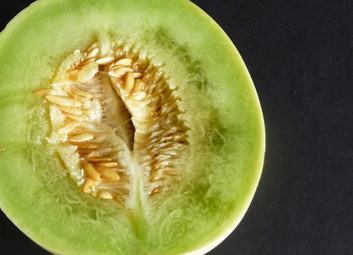Let's talk about Honeydew.
I know, it's the blah placeholder in hotel and restaurant fruit salads. I know it's filler. I know that its blah-ness has annoyed people to the point of outrage. Kirsten King on BuzzFeed said, "It's about time we acknowledge the havoc honeydew melon is wreaking on all of our lives."
(No hyperbole there.)

Honeydew melon. Not actually wreaking havoc on anyone's life, and actually capable of being delicious.
(Photo from ProduceGreek)
King goes further, saying, "honeydew has this magic* ability to stay unripe [This, by the way, is categorically untrue] and taste like you're biting into a ball of spa-flavored Styrofoam." Her asterisk takes you to another asterisk which says "*shitty".
Then she puts gigantic capital red letters over various stock photos of people, shouting things like, PUT HONEYDEW IN MY SALAD AND I WILL CUT U. Over a picture of a couple happily eating fruit salad on a beach balcony she wrote, FINDS HONEYDEW IN SALAD, GETS DIVORCE.
OK, that last one is funny.
The point is, people are annoyed by honeydew. I get it. I've lost patience with it too -- in those crappy pre-made fruit salads. Even The New York Times is fed up with honeydew (or maybe just Josh Barro at the NYT): "Every time I see a fruit platter at a hotel or a conference, I ask myself the same question: Where does all this honeydew melon come from, and does anyone actually want to eat it?"
Dawn Eisner, who used to be head of the buffet at the Radisson Plaza in Kalamazoo, Michigan (rather an odd source for Barro's article, but OK), said, “Nobody eats the green melon.” So why even serve it? “It looks nice next to watermelon, cantaloupe and pineapple.”
In other words, who cares what it tastes like? It looks good. That's its sole purpose on the plate. Can you imagine the aneurysm Tom Colicchio would have if he heard such a statement?

"You put something on the plate just for looks? And you don't care how it tastes? That's criminal."
(Photo of Chef Tom Colicchio from Bravo, sourced from the Dallas Observer)
One sentence tucked into the midriff of Barro's article says, "Partisans emphasized to me the importance of finding the right honeydew melon; under their theory, those of us who think we dislike honeydew are just scarred from all the hotel breakfasts and conference buffets where it is served underripe and out of season."
This theory is correct.
Ladies and gentlemen, don't blame the melon. In fact, never blame the fruit. Just as rock-hard underripe peaches sold in chain grocery stores across the country are giving peaches everywhere a bad name, so too are these hunks of underripe honeydew dumped into piles of fruit that lazy-ass hoteliers and cheap-ass restaurant owners want to call a fruit salad. That is not fruit salad. That is a bowl of laziness and food maltreatment that they want you to think is fruit salad. That's somebody trying to work a Jedi mind trick on you and failing miserably.

The hotel & restaurant miserable fruit cup. Giving a bad name to good fruit everywhere.
(Yes, this is a stock photo that I did not pay for. That's what these lousy fruit cups are worth. And what the heck is that meat on the plate? From alamy.)
Think about it. Fruit is nature's sugar-enticement. Fruit is intentionally designed to make you want to eat it. That plant's continued survival depends on you eating its fruit and fertilizing its seeds. It is a matter of life and death for that plant that it must taste good. If a fruit doesn't taste good, nobody eats it, the plant dies.
By serving these lousy, underripe, half-frozen, tasteless hunks of what never had the chance to become full-fledged honeydew, wedding caterers and buffet managers everywhere are contributing to the death of a species -- Cucumis melo, to be exact.
So, let's get to some truths about honeydew melon and maybe we can rescue it -- and ourselves -- from perdition.
I know, it's the blah placeholder in hotel and restaurant fruit salads. I know it's filler. I know that its blah-ness has annoyed people to the point of outrage. Kirsten King on BuzzFeed said, "It's about time we acknowledge the havoc honeydew melon is wreaking on all of our lives."
(No hyperbole there.)

Honeydew melon. Not actually wreaking havoc on anyone's life, and actually capable of being delicious.
(Photo from ProduceGreek)
King goes further, saying, "honeydew has this magic* ability to stay unripe [This, by the way, is categorically untrue] and taste like you're biting into a ball of spa-flavored Styrofoam." Her asterisk takes you to another asterisk which says "*shitty".
Then she puts gigantic capital red letters over various stock photos of people, shouting things like, PUT HONEYDEW IN MY SALAD AND I WILL CUT U. Over a picture of a couple happily eating fruit salad on a beach balcony she wrote, FINDS HONEYDEW IN SALAD, GETS DIVORCE.
OK, that last one is funny.
The point is, people are annoyed by honeydew. I get it. I've lost patience with it too -- in those crappy pre-made fruit salads. Even The New York Times is fed up with honeydew (or maybe just Josh Barro at the NYT): "Every time I see a fruit platter at a hotel or a conference, I ask myself the same question: Where does all this honeydew melon come from, and does anyone actually want to eat it?"
Dawn Eisner, who used to be head of the buffet at the Radisson Plaza in Kalamazoo, Michigan (rather an odd source for Barro's article, but OK), said, “Nobody eats the green melon.” So why even serve it? “It looks nice next to watermelon, cantaloupe and pineapple.”
In other words, who cares what it tastes like? It looks good. That's its sole purpose on the plate. Can you imagine the aneurysm Tom Colicchio would have if he heard such a statement?

"You put something on the plate just for looks? And you don't care how it tastes? That's criminal."
(Photo of Chef Tom Colicchio from Bravo, sourced from the Dallas Observer)
One sentence tucked into the midriff of Barro's article says, "Partisans emphasized to me the importance of finding the right honeydew melon; under their theory, those of us who think we dislike honeydew are just scarred from all the hotel breakfasts and conference buffets where it is served underripe and out of season."
This theory is correct.
Ladies and gentlemen, don't blame the melon. In fact, never blame the fruit. Just as rock-hard underripe peaches sold in chain grocery stores across the country are giving peaches everywhere a bad name, so too are these hunks of underripe honeydew dumped into piles of fruit that lazy-ass hoteliers and cheap-ass restaurant owners want to call a fruit salad. That is not fruit salad. That is a bowl of laziness and food maltreatment that they want you to think is fruit salad. That's somebody trying to work a Jedi mind trick on you and failing miserably.

The hotel & restaurant miserable fruit cup. Giving a bad name to good fruit everywhere.
(Yes, this is a stock photo that I did not pay for. That's what these lousy fruit cups are worth. And what the heck is that meat on the plate? From alamy.)
Think about it. Fruit is nature's sugar-enticement. Fruit is intentionally designed to make you want to eat it. That plant's continued survival depends on you eating its fruit and fertilizing its seeds. It is a matter of life and death for that plant that it must taste good. If a fruit doesn't taste good, nobody eats it, the plant dies.
By serving these lousy, underripe, half-frozen, tasteless hunks of what never had the chance to become full-fledged honeydew, wedding caterers and buffet managers everywhere are contributing to the death of a species -- Cucumis melo, to be exact.
So, let's get to some truths about honeydew melon and maybe we can rescue it -- and ourselves -- from perdition.
- Honeydew was first grown in the tropics of West Africa, and then the French discovered it. They cultivated it in southern France and most particularly in Antibes. The name of the cultivar that we now grow in California and Arizona is called the White Antibes.

Antibes in southern France is on the coast of the Mediterranean between Cannes and Nice. Napoleon lived here for a while, at first by choice and then in prison. For centuries, this has been a favorite spot for celebrities, everyone from F. Scott Fitzgerald to Madonna. You think these people are going to eat lousy melons, or do you think they're going to eat some of the most delicious melon in the world?
(Photo from SunHat France)
- Honeydew is also popular in China. It was an American who introduced honeydew to the Chinese -- finally, something we brought to them instead of the other way around. It was a former US Secretary of Agriculture, Henry A. Wallace, who had founded his own seed company, Pioneer Hi-Bred, who gave seeds of the honeydew to some Chinese planters when he was there on a visit.
- Let's put that in perspective too. A guy who had been in charge of the entire US Department of Agriculture, who knows all the good stuff that can be grown in this country, and starts his own seed company, gives what to the Chinese? Honeydew. "I think this is good and I think you'll like it too" -- and he's saying that about honeydew.
- In China, honeydew are sometimes called Wallace melons, after the guy who gave them the seeds.
- (Wallace went on to become Vice President of the United States under FDR.)

Honeydew grow on the ground among vines, like their relatives the cantaloupe and pumpkin and cucumber. It is possible to grow them off the ground on trellises, but the melons get so heavy, it's best to support them with specially-made slings.
(Photo from Cherry Gal)
- A lot of people say if they're going to eat melon, they'd prefer to eat cantaloupe rather than honeydew. I think they think the cantaloupe is sweeter. But in nutritional terms, honeydew & cantaloupe are the same. Same amount of sugar per slice, same amount of calories.
- Cantaloupe is also often victim to being served underripe or cut too close to the rind. But since it's easier to tell when you're doing that to cantaloupe, because the flesh of the melon will be an obvious green versus orange, that doesn't happen as often as it does with honeydew. Even so, a lot of places do serve green-edged cantaloupe.

If you look closely, you can see that the edges of the cut chunks of this melon are green. This is a major violation in melon-eating. If you get a fruit cup and it's got cantaloupe with green corners on it like this, send it back. Don't stand for this unripe melon business anymore!
(Photo from CitiClean)
- In fact, those green corners on cantaloupe are, to me, the bellweather indicator for how good or lousy a fruit salad is going to be. If I see those green corners in a container of fruit, I won't buy it. Somebody doesn't care enough to get the cantaloupe right, they're probably not going to get anything else in the salad right either.
- Even if they did get the cantaloupe right, they probably didn't get the honeydew right. One of the ways they may have gotten honeydew wrong is they may have frozen it. This is just outright idiocy, but some people do it.
- Don't freeze the honeydew. You might as well suck all the flavor right out of it and call it a sponge. There's no resurrecting it after it's been frozen.
- More often, people serve honeydew when it's just plain not ripe. To be fair, it is not always easy to tell if a honeydew is ripe. Here are some of the indicators to look for:
- The outside skin should be a creamy, near-yellow color.
- If it's white, it's not ripe
- The skin should feel almost waxy, not fuzzy.
- The melon should feel really heavy when you pick it up. (The cashier said after she'd bagged my honeydew, "Feels like you got a head in there." And no, I do not mean the dirty pun -- either of them.)
- Press the round spot on either end of the melon. (I think of this as the fontanelle.) It should give a little to pressure.
- Run your hand over the surface of the melon. If you can distinguish fine wrinkling, it's ready.
- Smell it. If you don't smell anything, it's not ripe. If you smell the soft scent of melon, it's ready.
- If the outside is creamy-colored but it's dinged up and looking a little bruised, it's probably overripe. But if you're going to eat the whole thing today and every other melon is not even close to being ripe, that might be the best choice in the bin.
- The Produce Guy says the honeydew is probably the easiest melon to tell when it's ripe, but interestingly enough, he kind of gets his selection wrong in this video. His method (45 seconds in) is to wet his thumb & wipe it off on his clothes to remove the oils present in his skin, and then rub his thumb on the outer surface of the melon. He says if it squeaks, the melon is ripe. In my opinion, there are a lot of reasons why this method could produce faulty results, and it looks like that's what happened in this instance.
- Something else to consider is the time of year. Honeydew does have a season, in spite of the fact that it seems to be always present in produce sections and fruit cups all year long. Honeydew are best at the end of summer, beginning of September.
- The good news is, once you get a honeydew home from the store, it will continue to ripen at room temperature.
- I just want to highlight this statement because it directly contradicts Kirsten King's hyperbolic and crude and factually incorrect remark that honeydew have some magic ability to stay unripe. In fact, honeydew are the only type of melon that will ripen after it's been picked, even if it has been picked way too early.
- Since most melons (and most fruit in general) that are sold in grocery stores are sold in a very underripe state, it may take a couple days before your honeydew is fully ready.
- If you want it to ripen faster, put the honeydew in a paper bag. This will trap the chemicals the fruit emits during the ripening process, and you'll hasten ripening maybe by about a day's worth or so.
- If you want to delay ripening, or keep your ripe melon from becoming too ripe, that's when you put it in the refrigerator. But in most cases, once you've got your melon home, refrigeration won't be necessary.
- After you cut it open, then you'll want to refrigerate it.

This honeydew is overripe. See how the flesh has turned dark in places, almost to a liquid? You could still use this, I suppose, but the flavor will be a little off, not quite as light and delightful as it should be.
(Photo from Everyday Healthy! Everyday Delicious!)

Here's the overripeness in cube form. The points on some of these chunks are kind of a yellowish-green. They've gone too soft, almost pithy.
(Photo from Everyday Healthy! Everyday Delicious!)

Also not what you want to see in cubed honeydew. Pale, almost white, no juicy glisten, unripe tough green at the corners. Unappetizing.
(Photo from Aunt Mid's)

This is what cubed honeydew should look like. Mostly green, glistening with juice, firm but with a little bit of softness at the part where the seeds grew. Much more appealing.
(Photo from Fresh Start Foods)
- When you cut open your honeydew, scoop out the seeds only from the part you're going to eat. Leave the seeds in the other portion, wrap it snugly in plastic wrap, and put that in the fridge. The seeds will help the melon stay a little fresher longer.
- Once you've scooped out the seeds from the part you're going to eat, when you cut away the rind, aim for about 1/4 inch away from the rind. You don't want to cut too close to the peel because the flesh tends to be tougher there and have less flavor. That tougher flesh also looks whiter than the rest of the melon, so cut off whatever looks white and keep what looks green.
- (That's another thing the Produce Guy got wrong; he cut way too close to the rind.)

See how the flesh of the cut melon gets lighter right next to the rind? That's what you want to cut away.
(Photo from fit brains)
- You can eat every part of the honeydew, by the way. The rind can be pickled and the seeds you can roast, the same way you do with pumpkin seeds.
- As with any fruit, you can assist the flavor of the cut honeydew by sprinkling it with sugar and lemon juice. Let it sit in the sugar & lemon for a bit, and it will start to break into the fruit and release more flavor. Chefs call this "macerating" the fruit, which sounds either violent or sexual. But it's only lemon juice & sugar.
- If the fruit is fully ripe, that shouldn't be necessary. The fruit should be juicy & sweet enough on its own.
- All that should pay off with this: the taste of a ripe, delicious, juicy honeydew. When you cut into the melon, juice will run out and you'll be able to smell its light, sweet fragrance. When you bite into a piece, it will be soft and giving, and the taste will be somewhat delicate but still sweet, with a kind of light green lusciousness. It has almost a pear-like texture but without the graininess. It will be smooth, cool, juicy, delightful, sweet, lovely, and lush.
- Now that's a honeydew.

I got a honeydew from the store today, knowing I was going to do this entry. I'm going to go downstairs right now and see if it's ripe.
(Photo from Food for Thought)
P.S. I almost forgot to tell you my favorite honeydew joke!
What did the two melons say to each other?
"Sorry, dear, I cantaloupe."
"Oh, honeydew."
Ba-dum-ching!
Sources
Josh Barro, That Honeydew Melon Looks Good, but Does Anyone Eat It? The New York Times, August 2, 2014
WebMD, Honeydew: 7 Fun Facts
University of Arizona, Collecge of Agrciulture and Life Sciences, Honeydew Melons (use to this source with caution; there are a lot of contradictory and even incorrect statements here)
Tucson Community Supported Agriculture, About Honeydew Melons
ProduceGreek, Eat This Now for the Week of 8/16/10
SFGate, Do Melons Ripen Once They Are Picked?
SFGate, Do Melons Ripen Once They Are Picked?













